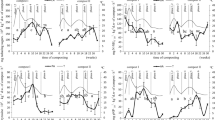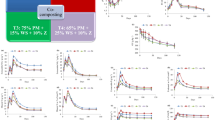Summary
A series of straw composts, containing two levels of ammonium nitrate, were incubated with mineral amendments. Rate of decomposition was at a maximum over the first twenty days and was not influenced by the level of added nitrogne. The presence of bentonite and kaolinite reduced the loss of organic material slightly over the period of 150 days. In the low-N series, all the added inorganic nitrogen was immediately immobilized but in the high-N series inorganic N was slightly in excess of the microorganisms requirements. Little or no remineralization occurred. As a result of immobilization there was a rapid increase in amino acid and amino sugar nitrogen over the first 30 days and the values then remained fairly constant. The amino acid and amino sugar levels were slightly higher in the composts containing bentonite and kaolinite.
In the early stages of the composting process, approximately half the organic nitrogen was soluble in phosphate buffer but the amount decreased with time of composting. Similarly, the amount of extracted nitrogen which could be hydrolysed by proteolytic enzymes, decreased with time. The composition of amino sugars liberated by acid hydrolysis suggested that chitin, probably of fungal origin, accounted for much of the amino sugar nitrogen and there is some evidence from oxidation studies for this. As composting proceeded, the amount of galactosamine increased and eventually muramic acid was identified indicating an increase in the bacterial flora.
Similar content being viewed by others
References
Belcher, R., Nutten, A. J. and Sambrook, C. M. 1954 The determination of glucosamine. Analyst79, 201–208.
Boas, H. F. 1953 Method for the determination of hexosamines in tissues. J. Biol. Chem.204, 553–563.
Bremner, J. M. 1965 Total nitrogen.In Methods of Soil Analysis, Part 2, Ed. C. A. Black. pp. 1149–1178. Agron. Mono. No.9, Wisconsin.
Bremner, J. M. and Keeney, D. R. 1966 Determination and isotope-ratio analysis of different forms of nitrogen in soils. 3. Exchangeable ammonium, nitrate, and nitrite by extraction-distillation methods. Soil Sci. Soc. Am. Proc.30, 577–582.
Broadbent, F. E. and Nakashima, T. 1976 Reversion of fertilizer nitrogen in soils. Soil Sci. Soc. Am. Proc.31, 648–652. (1967).
Cheng, H. H. and Kurtz, L. T. 1963 Chemical distribution of added nitrogen in soils. Soil Sci. Soc. Am. Proc.27, 312–316.
Chichester, F. W. 1969 Nitrogen in the soil organo-mineral sedimentation fractions. Soil Sci.107, 356–363.
Crumpton, M. J. 1959 Identification of amino sugars. Biochem. J.72, 479–486.
Ensminger, L. E. and Gieseking, J. E. 1939 The adsorption of proteins by montmorillonite. Soil Sci.48, 467–474.
Goto, M. and Kakita, Y. 1959 Studies on the extraction and determination of metal salts with methyl isobutyl ketone. 1. Extraction with acid solution. Sci. Rep. Res. Inst., Tokyo Univ., Ser A,11, 1–20.
Hoyle, D. A. and Mattingly, G. E. G. 1954 Studies on composts prepared from waste materials. I. Preparation, nitrogen losses and changes in “soluble nitrogen”. J. Sci. Food Agric.5, 54–64.
Hutchison, H. B. and Richards, E. H. 1921 Artificial farmyard manure. J. Min. Agric.28, 389–411.
Jansson, S. L. 1958 Nitrogen transformations in soil. Lantbrukshoegsk. Ann24, 101–361.
Jansson, S. L., Hallam, M. J. and Bartholomew, W. V. 1955 Preferential utilization of ammonium over nitrate by microorganisms in the decomposition of oat straw. Plant and Soil6, 382–390.
Ladd, J. N., Parsons, J. W. and Amato, M. 1977 Studies on nitrogen immobilization and mineralization in calcareous soils. I. Distribution of immobilized nitrogen amongst soil fractions of different particle size and density. Soil Biol. Biochem.9, 309–318.
Sørenson, L. H. 1972 Stabilization of newly formed amino acid metabolites in soils by clay minerals. Soil Sci.114, 5–11.
Stewart, B. A., Porter, L. K. and Johnson, D. D. 1963 Immobilization and mineralization of nitrogen in several organic fractions of soil. Soil Sci. Soc. Am. Proc.27, 302–304.
Swaby, R. J. and Ladd, J. N. 1962 Chemical nature, microbial resistance and origin of soil humus. Trans. Int. Soil Sci. Soc., N.Z., CommIV, 197–202.
Tinsley, J. and Nowakowski, T. Z. 1959 The composition and manurial value of poultry excreta, straw-droppings compost and deep litter. II. Experimental studies on composts. J. Sci. Food Agric.10, 150–167.
Watson, J. R. and Parsons, J. W. 1974 Studies of soil organo-mineral fractions. I. Isolation by ultrasonic dispersion. Soil Sci.25, 1–8.
Wise, L. E. Murphy, M. and D'Addiego, A. A. 1966 Chlorite holocellulose, its fractionation and bearing on the summative wood analysis and on studies on the hemicelluloses. Pap. Trade J.122, 35–43.
Yemm, E. W. and Cocking, E. C. 1955 The determination of amino acids with ninhydrin. Analyst80, 209–213.
Author information
Authors and Affiliations
Rights and permissions
About this article
Cite this article
Beckwith, C.P., Parsons, J.W. The influence of mineral amendments on the changes in the organic nitrogen components of composts. Plant Soil 54, 259–270 (1980). https://doi.org/10.1007/BF02181852
Received:
Issue Date:
DOI: https://doi.org/10.1007/BF02181852




